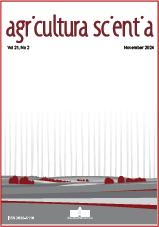Evaluation of Heifer Welfare in Two Different Rearing Systems
DOI:
https://doi.org/10.18690/agricsci.21.2.2Keywords:
animal welfare, cattle, heifer, rearing system, assessment protocolAbstract
The welfare of domestic animals, which is a core part of livestock farming today, depends strongly on the rearing system. While free-stall systems are encouraged, tied rearing systems are still the most widely used in cattle farming, although considered less suitable due to restricted freedom of movement. As an alternative to this system, free-stall rearing, which allows movement, is proposed as a minimum standard. Although it seems self-evident that free-stall rearing is better than tied rearing system, there is still a lack of research on whether this is true for all categories of cattle or whether it might be appropriate for some of them (e.g. depending on age). The aim of the present study was therefore to compare the welfare of heifers in tied and free-stall rearing during the fattening period (at different ages). In general, we have suggested higher welfare scores in free-stall system, with the tied stall being more problematic for younger animals. The study comprised five heifers in each system per repetition (20 animals in total). Data were collected using the Welfare Quality® protocol, which involves the assessment of four main principles: feeding, housing, health and behaviour. The assessments were carried out approximately every three months during the fattening period (from 6 to 27 months of age). The results showed significant differences in animal welfare scores between tied and free-stall systems only in
terms of housing and the tendency of differences in behaviour. For both principles, the scores were relatively low compared to feeding and health, where no differences were found between the rearing systems. In terms of temporal dynamics, differences were only found for housing, with values decreasing with age in both rearing systems. In the free-stall system, the scores were almost optimal in young animals (>90), but decreased rapidly with increasing age, while in the tied housing system, a suboptimal welfare scores were already observed in young animals (≈40). This means that tied rearing system is a clear disadvantage for the welfare of younger animals, which are generally more exploratory and active. Our results confirmed tied stall as less suitable in terms of animal welfare, especially for young animals. It is therefore encouraged that young animals should primarily be housed in a freestall pens if both systems are available in the breeding facilities.
Downloads
Downloads
Published
Issue
Section
License
Copyright (c) 2025 Ernest Plemenitaš, Dejan Škorjanc, Janko Skok, Maja Prevolnik Povše

This work is licensed under a Creative Commons Attribution-NonCommercial-NoDerivatives 4.0 International License.
